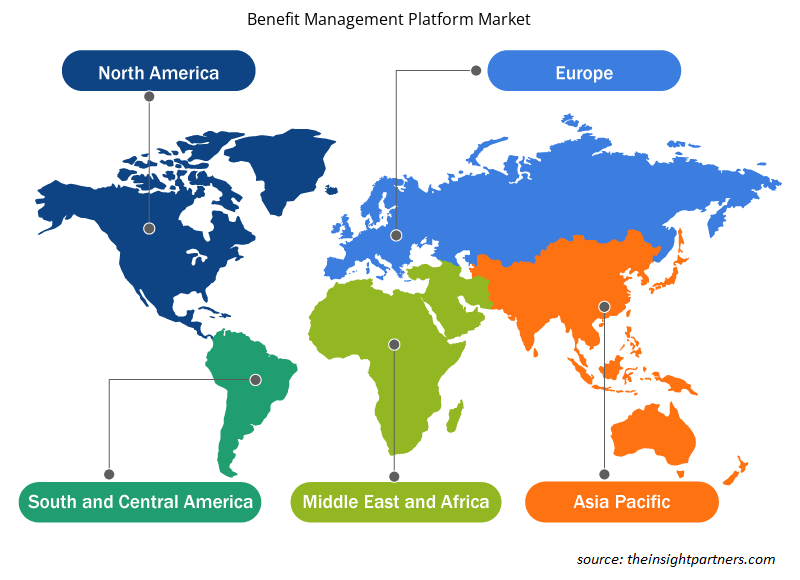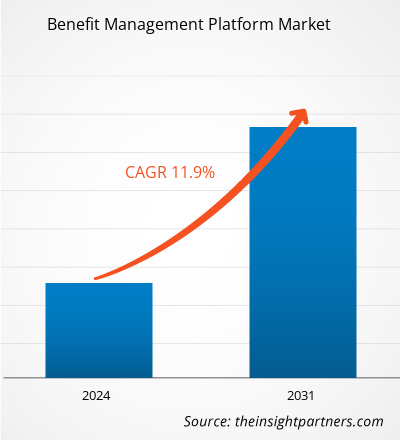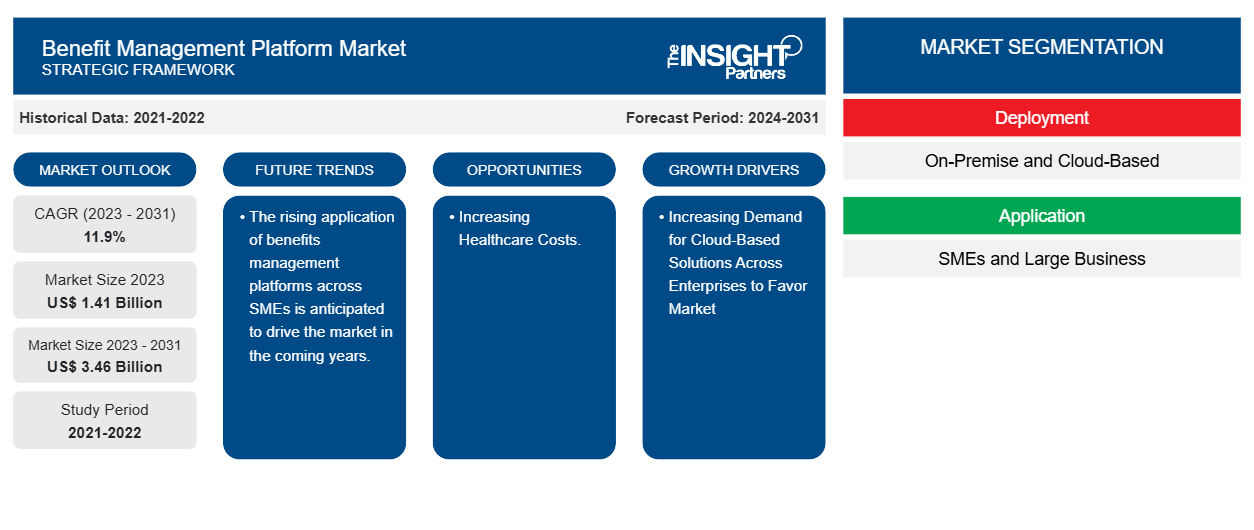福利厚生管理プラットフォームの市場規模は、2023 年の 14 億 1,000 万米ドルから 2031 年には 34 億 6,000 万米ドルに達すると予測されています。市場は 2023 年から 2031 年にかけて 11.9% の CAGR を記録すると予想されています。さまざまな企業でのクラウドベースのソリューションの成長と医療費の上昇は、今後も市場の主要なトレンドと推進要因であり続けると思われます。
福利厚生管理プラットフォーム市場分析
福利厚生管理プラットフォーム市場の需要は、企業全体でのクラウドベースのソリューションの増加と、テクノロジーに支えられた利便性に対する需要の高まりにより、増加すると予想されます。医療費の高騰が市場の成長を後押ししています。さらに、いくつかの政府の取り組みと中小企業全体でのアプリケーションの増加が、予測期間中の市場の成長を促進すると予想されます。
福利厚生管理プラットフォーム市場の概要
福利厚生管理プラットフォームは、従業員の行動を認識し、雇用主が効率的な事業運営のためにさまざまな福利厚生を提供できるように設計されています。このようなソリューションは、従業員の士気を高め、組織内での雇用に報いるために役立ちます。これらのプラットフォームは、その技術革新により、ほぼあらゆる規模の企業で頻繁に使用されています。
要件に合わせてレポートをカスタマイズする
このレポートの一部、国レベルの分析、Excelデータパックなど、あらゆるレポートを無料でカスタマイズできます。また、スタートアップや大学向けのお得なオファーや割引もご利用いただけます。
- このレポートの主要な市場動向を入手してください。この無料サンプルには、市場動向から見積もりや予測に至るまでのデータ分析が含まれます。
福利厚生管理プラットフォーム市場の推進要因と機会
企業全体でクラウドベースのソリューションの需要が高まり、市場が好調
企業全体でのクラウドベースのソリューションに対する需要の高まりが、福利厚生管理プラットフォーム市場の成長を牽引しています。クラウドベースのソリューションは、新しい従業員を追加する場合でも、グローバルに拡大する場合でも、企業の成長に合わせて簡単に拡張できます。福利厚生管理プラットフォームは、IT サブスクリプション モデルのコストを削減することもできます。さらに、リアルタイムの更新へのリモート アクセスを強化します。さらに、市場にはいくつかの福利厚生管理プラットフォームがあります。たとえば、Zenefits は、福利厚生管理、給与処理、時間追跡、コンプライアンス管理など、幅広い機能を提供するクラウドベースの HR プラットフォームです。さらに、従業員が福利厚生を管理するための直感的なインターフェイスを提供し、さまざまなサードパーティ アプリケーションと統合します。このように、企業全体でのクラウドベースのソリューションに対する需要の高まりが市場の成長を牽引しています。
医療費の増加。
近年、医療費の高騰は、雇用主と従業員の両方にとって差し迫った懸念となっています。医療費が着実に上昇する中、従業員の福利厚生の持続可能性が厳しく精査されています。医療費がますます高くなるにつれて、企業はコストを効果的に管理しながら優秀な人材を引き付け、維持する強力な福利厚生パッケージを維持するという課題に直面しています。これにより、福利厚生管理プラットフォームの需要が高まっています。医療費が上昇するにつれて、雇用主と個人は経費を管理および削減する方法を模索しています。したがって、医療費の上昇は、福利厚生管理プラットフォーム市場にとって大きなチャンスとなります。
福利厚生管理プラットフォーム市場レポートのセグメンテーション分析
福利厚生管理プラットフォーム市場分析の導出に貢献した主要なセグメントは、開発とアプリケーションです。
- 開発に基づいて、福利厚生管理プラットフォーム市場はオンプレミスとクラウドベースに分かれています。クラウドベースのセグメントは、予測期間中に大きなシェアを占めると予想されます。
- アプリケーションに基づいて、福利厚生管理プラットフォーム市場は中小企業と大企業に分かれています。中小企業セグメントは予測期間中に大きなシェアを占めると予想されます。
地域別の福利厚生管理プラットフォーム市場シェア分析
福利厚生管理プラットフォーム市場レポートの地理的範囲は、主に北米、アジア太平洋、ヨーロッパ、中東およびアフリカ、南米および中米の 5 つの地域に分かれています。
北米が市場を支配しています。北米の市場の成長は、クラウドベースのソリューションの採用の増加と、効率的な従業員福利厚生管理の需要の高まりに起因しています。また、従業員の福利厚生を分析および管理するための自動化ソリューションの需要も高まっています。さらに、この地域の技術の進歩と研究開発への絶え間ない重点が市場の成長に寄与しています。この地域には、多数の福利厚生管理プラットフォームプロバイダーが存在します。これらすべての要因が、北米で福利厚生管理プラットフォーム市場の成長を牽引し、勢いを増しています。
福利厚生管理プラットフォーム市場の地域別分析
予測期間を通じて福利厚生管理プラットフォーム市場に影響を与える地域的な傾向と要因は、Insight Partners のアナリストによって徹底的に説明されています。このセクションでは、北米、ヨーロッパ、アジア太平洋、中東およびアフリカ、南米および中米にわたる福利厚生管理プラットフォーム市場のセグメントと地理についても説明します。

- 福利厚生管理プラットフォーム市場の地域別データを入手
福利厚生管理プラットフォーム市場レポートの範囲
| レポート属性 | 詳細 |
|---|---|
| 2023年の市場規模 | 14億1000万米ドル |
| 2031年までの市場規模 | 34億6千万米ドル |
| 世界のCAGR(2023年~2031年) | 11.9% |
| 履歴データ | 2021-2022 |
| 予測期間 | 2024-2031 |
| 対象セグメント | 展開別
|
| 対象地域と国 | 北米
|
| 市場リーダーと主要企業プロフィール |
|
福利厚生管理プラットフォーム市場のプレーヤー密度: ビジネスダイナミクスへの影響を理解する
ベネフィット管理プラットフォーム市場は、消費者の嗜好の変化、技術の進歩、製品のメリットに対する認識の高まりなどの要因により、エンドユーザーの需要が高まり、急速に成長しています。需要が高まるにつれて、企業は提供内容を拡大し、消費者のニーズを満たすために革新を起こし、新たなトレンドを活用し、市場の成長をさらに促進しています。
市場プレーヤー密度とは、特定の市場または業界内で活動している企業または会社の分布を指します。これは、特定の市場スペースに、その市場規模または総市場価値に対してどれだけの競合相手 (市場プレーヤー) が存在するかを示します。
福利厚生管理プラットフォーム市場で事業を展開している主要企業は次のとおりです。
- Benefitfocus.Com 株式会社
- BスウィフトLLC
- エンピリアン
- 従業員ナビゲーター
- 容易に
- ADP株式会社
免責事項:上記の企業は、特定の順序でランク付けされていません。

- 福利厚生管理プラットフォーム市場のトップキープレーヤーの概要を入手
福利厚生管理プラットフォームの市場ニュースと最近の動向
福利厚生管理プラットフォーム市場は、主要な企業出版物、協会データ、データベースなどの一次調査と二次調査後の定性的および定量的データを収集することによって評価されます。福利厚生管理プラットフォーム市場におけるいくつかの開発を以下に示します。
- キャップジェミニは、フィンランドの失業給付受給者約100万人をサポートする統合給付管理システムを開発するため、カリオ・ソフトウェアと新たな契約を締結したことを発表しました。この新しいプラットフォームは、給付申請プロセスの処理をより迅速かつ顧客中心にし、顧客体験を向上させるように設計されています。(出典: キャップジェミニ、企業ウェブサイト、2024年5月)
- BambooHR は、福利厚生登録プロセスを簡素化するためのソリューションである Benefits Administration を開始しました。Benefits Administration は、従業員の福利厚生登録を BambooHR プラットフォームに統合し、すべてのユーザーに迅速かつ便利なエクスペリエンスを提供します。
(出典:BambooHR、企業ウェブサイト、2023年6月)
福利厚生管理プラットフォーム市場レポートの対象範囲と成果物
「福利厚生管理プラットフォーム市場規模と予測(2021〜2031年)」レポートでは、以下の分野をカバーする市場の詳細な分析を提供しています。
- 範囲内でカバーされるすべての主要な市場セグメントについて、世界、地域、国レベルでの福利厚生管理プラットフォームの市場規模と予測。
- 福利厚生管理プラットフォーム市場の動向、および推進要因、制約、主要な機会などの市場動向。
- 詳細なPEST/ポーターの5つの力とSWOT分析
- 主要な市場動向、世界および地域の枠組み、主要プレーヤー、規制、最近の市場動向を網羅した福利厚生管理プラットフォーム市場分析。
- 市場集中、ヒートマップ分析、主要プレーヤー、福利厚生管理プラットフォーム市場の最近の動向を網羅した業界の状況と競争分析。
- 詳細な企業プロフィール。
- 過去2年間の分析、基準年、CAGRによる予測(7年間)
- PEST分析とSWOT分析
- 市場規模価値/数量 - 世界、地域、国
- 業界と競争環境
- Excel データセット
最新レポート
関連レポート
お客様の声
購入理由
- 情報に基づいた意思決定
- 市場動向の理解
- 競合分析
- 顧客インサイト
- 市場予測
- リスク軽減
- 戦略計画
- 投資の正当性
- 新興市場の特定
- マーケティング戦略の強化
- 業務効率の向上
- 規制動向への対応























 無料サンプルを入手 - 福利厚生管理プラットフォーム市場
無料サンプルを入手 - 福利厚生管理プラットフォーム市場